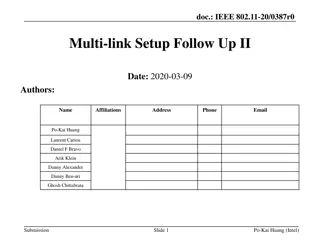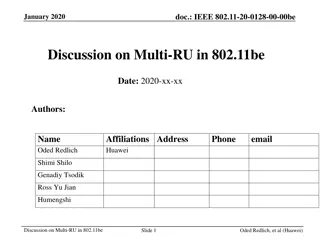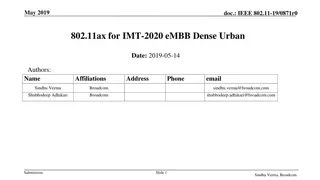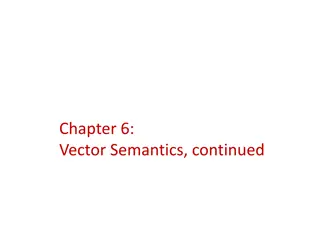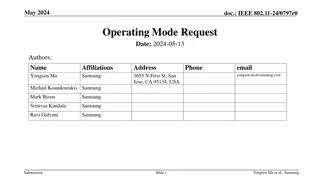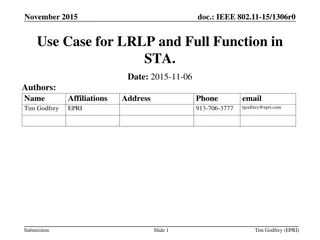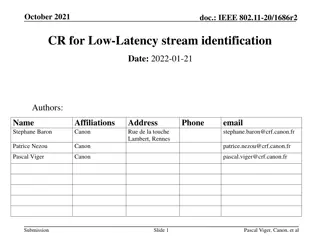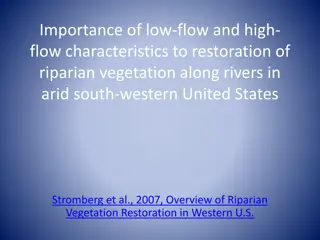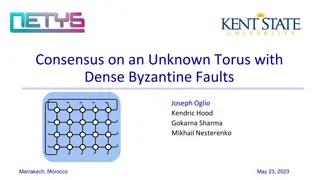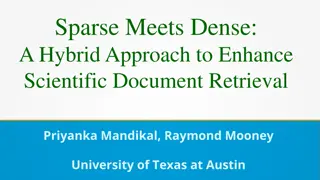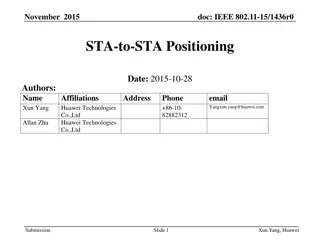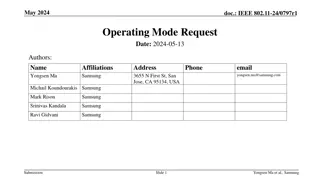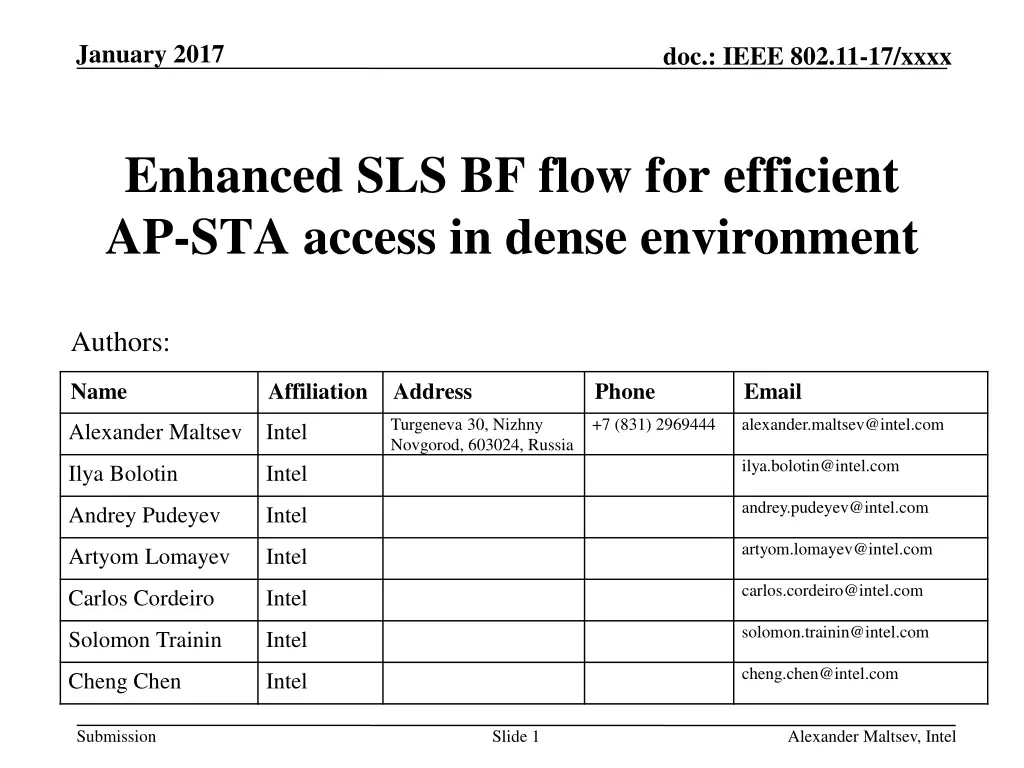
Enhanced SLS Beamforming for Efficient AP-STA Access
Explore the advancements in IEEE 802.11 technology with Enhanced SLS Beamforming to address coverage and collision challenges in dense environments. This document discusses issues in asymmetrical AP-STA configurations, improved channel access for distant STAs, training enhancements, and comparative analyses between Legacy and Enhanced SLS approaches.
Uploaded on | 1 Views
Download Presentation

Please find below an Image/Link to download the presentation.
The content on the website is provided AS IS for your information and personal use only. It may not be sold, licensed, or shared on other websites without obtaining consent from the author. If you encounter any issues during the download, it is possible that the publisher has removed the file from their server.
You are allowed to download the files provided on this website for personal or commercial use, subject to the condition that they are used lawfully. All files are the property of their respective owners.
The content on the website is provided AS IS for your information and personal use only. It may not be sold, licensed, or shared on other websites without obtaining consent from the author.
E N D
Presentation Transcript
January 2017 doc.: IEEE 802.11-17/xxxx Enhanced SLS BF flow for efficient AP-STA access in dense environment Authors: Name Affiliation Address Phone Email Turgeneva 30, Nizhny Novgorod, 603024, Russia +7 (831) 2969444 alexander.maltsev@intel.com Alexander Maltsev Intel ilya.bolotin@intel.com Ilya Bolotin Intel andrey.pudeyev@intel.com Andrey Pudeyev Intel artyom.lomayev@intel.com Artyom Lomayev Intel carlos.cordeiro@intel.com Carlos Cordeiro Intel solomon.trainin@intel.com Solomon Trainin Intel cheng.chen@intel.com Cheng Chen Intel Submission Slide 1 Alexander Maltsev, Intel
January 2017 doc.: IEEE 802.11-17/xxxx Agenda Problem statement Legacy SLS beamforming flow Enhanced SLS and channel access for far away STAs Enhanced SLS training in BTI Enhanced SLS in Beamforming training allocation Channel access for far away STAs Legacy vs. Enhanced SLS comparative analysis Conclusions Submission 2 Alexander Maltsev, Intel
January 2017 doc.: IEEE 802.11-17/xxxx Problem statement (1/2) Due to new use cases and scenarios in 11ay now we have two PHY layer issues: ISSUE 1: Coverage reduction in asymmetrical AP-STA configuration Current 11ad SLS procedure considers the alternate AP and STA transmit antenna training while the receiver s antenna pattern is configured to the quasi-omni mode. Usually STA is equipped with smaller antenna and has less TX power than AP. Therefore, a distant STA, after detecting the DMG Beacon frame (which was sent in directional mode) from AP, can have insufficient link budget for sending a response that will be detected by AP in quasi-omni mode. Submission 3 Alexander Maltsev, Intel
January 2017 doc.: IEEE 802.11-17/xxxx Problem statement (2/2) ISSUE 2: Collision in dense environment Current 11ad SLS procedure considers no more than 8 SSW slots per A-BFT interval randomly chosen by STAs. Collision may occur when several DMG STA choose the same SSW slot. The collision probability becomes higher in dense environments considered in 11ay 11ay mitigates this issue by adding new SSW slots in A-BFT for EDMG STAs. However, this may require an excessive number of SSW slots in case of dense environments and does not resolve the coverage issue for large antenna arrays Submission 4 Alexander Maltsev, Intel
January 2017 doc.: IEEE 802.11-17/xxxx Legacy SLS beamforming flow BTI A-BFT SSW slot SSW Feedback DMG Beacon Sector ID = N-1 DMG Beacon Sector ID = 0 DMG Beacon Sector ID = 1 . . . Initiator - AP . . . COLLISION I-TXSS Responder DMG STA X R-TXSS Responder DMG STA Y R-TXSS SSW frame Responder DMG STA Z R-TXSS Submission 5 Alexander Maltsev, Intel
January 2017 doc.: IEEE 802.11-17/xxxx Enhanced SLS and channel access for far away STAs Submission 6 Alexander Maltsev, Intel
January 2017 doc.: IEEE 802.11-17/xxxx Proposed enhanced SLS in BTI (1/2) During the BTI (or several BTI in case of fragmented TXSS) the AP/PCP performs TXSS transmitting DMG Beacon frames through all sectors available, while the responder s antenna is configured to a quasi-omni pattern The TRN-R field can be appended to DMG Beacon frame Responder (EDMG STA) receives DMG Beacon frame in quasi-omni mode and uses the appended TRN-R field to train its own antenna pattern, discovering the best RX sector. BTI DMG Beacon Sector ID = 0 DMG Beacon Sector ID = 1 DMG Beacon Sector ID = N-1 Initiator EDMG AP . . . TX beamforming L- Data AGC TRN-R L-STF L-CE Header Omni RX TRN-R field Responder EDMG STA X DMG Beacon frame, received with the best quality Submission 7 Alexander Maltsev, Intel
January 2017 Enhanced SLS in Beamforming training allocation. STA s responses doc.: IEEE 802.11-17/xxxx Beamforming training allocation Directional allocation BTI A-BFT DTI BTI DTI Through the (EDMG) Extended Scheduled element, the AP/PCP can allocate a special Beamforming training allocation in the DTI where the following procedure takes place: DMG Beacon Sector ID = 0 DMG Beacon Sector ID = 1 DMG Beacon Sector ID = N-1 Initiator EDMG AP AP Directional RX . . . AP/PCP configures its RX antenna to directional mode. AP/PCP repeats the Sector Sweep in the same order as in the BTI but in the RX mode. Each responding STA transmits one frame in the Initiator s sector detected as the best one during BTI TXSS. The responder s transmission is performed in directional mode using the operating sector trained during BTI TRN-R (some level of TX-RX EDMG STA reciprocity is assumed). To avoid collisions inside one sector, several time slots (space-time slots) may be assigned for responders transmissions. TX . . . beamforming . . . DMG Beacon frame, received with the best quality Responder EDMG STA X Responder EDMG STA Y Responder EDMG STA Z Submission 8 Alexander Maltsev, Intel
January 2017 Enhanced SLS in Beamforming training allocation. STA s responses doc.: IEEE 802.11-17/xxxx Beamforming training allocation training allocation Beamforming Directional allocation allocation Directional BTI BTI A-BFT A-BFT DTI DTI BTI BTI DTI DTI Sector ACK After transmitting the frame during AP directional RX the responder starts listening sector. AP broadcasts a Sector ACK frame in each sector where it detected any STA transmission (energy detection may be enough). Sector ACK frame should contain the information about every STA which transmission is discovered in this sector and instruction for other STAs in this sector. AP directional RX in the operating . . . broadcasting Submission 9 Alexander Maltsev, Intel
January 2017 doc.: IEEE 802.11-17/xxxx Enhanced SLS flow Beamforming training allocation Directional allocation BTI A-BFT DTI BTI DTI Space-time slots Sector ACK DTI BTI A-BFT DMG Beacon Sector ID = 0 DMG Beacon Sector ID = 1 DMG Beacon Sector ID = N-1 . . . Initiator - AP . . . L- L-STF L-CE Data AGC TRN-R Header Omni RX TRN-R field Responder EDMG STA X Far away STAs Responder EDMG STA Y Responder EDMG STA Z Responder DMG STA L R-TXSS Submission 10 Alexander Maltsev, Intel
January 2017 doc.: IEEE 802.11-17/xxxx Channel access for far away STAs in directional allocation (1/2) The far away EDMG STAs, which managed to associate to the AP through the Enhanced SLS, will still have problems with channel access in DTI since STAs (including PCP/AP) normally use quasi-omni mode for receiving. We propose to use scheduling through the (EDMG) Extended Schedule element to address this issue by introduction of Directional Allocations. For each allocation in the (EDMG) Extended Schedule element, the PCP/AP may specify the AP s receive sector that will use to listen during this allocation: Hereby, we refer to this as a directional allocation The type of the allocation can be either CBAP or SP. Any transaction can take place in this allocation, including additional beamforming and data transmission Beamforming training allocation Directional allocation BTI A-BFT DTI BTI DTI Submission Slide 11 Intel Corporation
January 2017 doc.: IEEE 802.11-17/xxxx Channel access for far away STAs in directional allocation (2/2) The STAs behavior in allocations, that do not specify a receive sector, remains the same as legacy STAs can use the information from the (EDMG) Extended Schedule element to decide to communicate with the PCP/AP in the specific directional allocation corresponding to the sector selected in BTI: The STA can use the directional allocations in additional to non-directional allocations to perform any transaction An alternative method is for the PCP/AP use polling in CBAPs/SPs: Polling already defined in 11ad Has its own pros/cons compared to scheduling Required changes Need to modify the (EDMG) Extended Schedule element and add a field to indicate on which sector the PCP/AP will be listening during each allocation. Submission Slide 12 Intel Corporation
January 2017 doc.: IEEE 802.11-17/xxxx Legacy vs. Enhanced SLS comparative analysis Submission 13 Alexander Maltsev, Intel
January 2017 doc.: IEEE 802.11-17/xxxx Evaluation assumptions: Legacy SLS Simulations consist of different trials (4000 environment snaps) with several consecutive BIs within a trial (25 BIs used). All stations in the area have data to transmit and compete for the synchronization opportunities in A-BFT of each BI. Each station randomly (per BI) select SS slot in the A-BFT. The R-TXSS (Responder STA TX sector switching) order within SS slot stays the same for all BIs within a trial. Collision of two or more STAs in the same space-time resource means that all of them miss the current BI transmission. In case of collision, no more than RetryLim retransmissions allowed in current A-BFT. If the collision was not resolved during RetryLim retransmissions, random BI back-off is selected. Submission 14 Alexander Maltsev, Intel
January 2017 Evaluation assumptions: Enhanced SLS doc.: IEEE 802.11-17/xxxx For each trial random uniform STA deployment is modeled. The operating sectors are defined for AP and STAs. To transmit SSW frame, STA selects the space-time slot in Beamforming SP, corresponding to its operating sector: If several timeslots are assigned to one AP sector, then STA randomly selects one to transmit the SSW frame Collision of two or more STAs in the same space-time resource means that all of them miss the current BI transmission. In case of collision, random BI back-off is selected. Submission 15 Alexander Maltsev, Intel
January 2017 doc.: IEEE 802.11-17/xxxx Evaluation parameters Legacy Baseline: 8 SS slots, with 8 SSW frames (8 sectors per TX STA) Retransmissions within A-BFT 0 or 2 allowed Back-off disabled or 4 BIs Increased number of SS slots: 32 SS slots Enhanced SLS 256 sectors per TX/RX AP 0 or 4 timeslots per sector transmission Back-off disabled or 4 BIs Performance metrics: Throughput: the percentage of missed BIs (due to unresolved collisions during SLS) Latency: distribution of the data transmission delays (in BIs) Submission 16 Alexander Maltsev, Intel
January 2017 doc.: IEEE 802.11-17/xxxx Legacy-based SLS performance Alexander Maltsev, Intel Submission 17
January 2017 doc.: IEEE 802.11-17/xxxx Enhanced SLS performance Submission 18 Alexander Maltsev, Intel
January 2017 Legacy vs. Enhanced SLS comparison doc.: IEEE 802.11-17/xxxx Mode SLS duration 5.9 ms. (BTI + A-BFT) 8.4 ms. (BTI + A-BFT) 9.8 ms. (BTI + Beamforming SP) 17.4 ms. (BTI + Beamforming SP) Legacy: SSslots=8, RetryLim=0 Legacy: SSslots=32, RetryLim=2 Enh.SLS: APsectors=256, Slots per sector=1 Enh.SLS: APsectors=256, Slots per sector=4 Submission 19 Alexander Maltsev, Intel
January 2017 Coverage analysis: Legacy vs. Enhanced SLS doc.: IEEE 802.11-17/xxxx For AP coverage analysis the free space LOS environment absorption in 60 GHz band was assumed. Enhanced SLS enlarges the mmWave coverage exploiting AP large antenna arrays capabilities both in Downlink (AP->STA) and Uplink (STA->AP) operation. The coverage is limited only by FCC EIRP constraint (about 270m in DL mode), while Legacy SLS coverage (about 27m) is limited by STA antenna gain and transmit power, which are usually much lower comparing to AP. Parameter Value with O2 Number of AP ant. elements AP transmit power, dBm Number of STA ant. elements STA transmit power, dBm Receive sensitivity, dBm 16 32 64 128 256 512 10 10 13 16 8 10 -78 (0 MCS) 8 19 22 25 Enhanced SLS EIRP limit = 43 dBm Only 27 meters coverage for Legacy SLS Submission 20 Alexander Maltsev, Intel
January 2017 Conclusions based on simulation results Legacy 11ad approach with 8 SS slots in A-BFT cannot be used for dense scenarios: the BI miss percentage can be up to 60% for 50 STAs in the hotspot area The BI back-off is inefficient in terms of resource usage in case of low collision probability Both increased number of SS slots (Legacy-based) or proposed Enhanced SLS provide reasonable 2-3% of BI miss probability in case of dense environment (50 STAs) The overall SLS duration for the Enhanced SLS approach is comparable with the Legacy-based (on the overall BI length) The Legacy-based approach with increased number of SS slots may give the same BI miss probability, but only the Enhanced SLS can provide significant coverage increase doc.: IEEE 802.11-17/xxxx Submission 21 Alexander Maltsev, Intel
January 2017 doc.: IEEE 802.11-17/xxxx Straw Poll To deal with asymmetric DMG antenna configurations, the 11ay specification shall define an enhanced SLS protocol that enables beamforming training between an AP or PCP and non-AP or non- PCP STAs that includes the following steps: i) adding TRN-R subfields to DMG Beacon frames transmitted in the BTI; ii) beamforming training between the PCP/AP and non- PCP/non-AP STAs (as shown in slide 8-9); iii) scheduling of directional allocations in the DTI (as shown in slides 11-12) Submission 22 Alexander Maltsev, Intel

